Time: 2006 Category: traditional art
Region: Qinghai Province No.: VII-48
Applicant: Huangzhong County, Qinghai Province
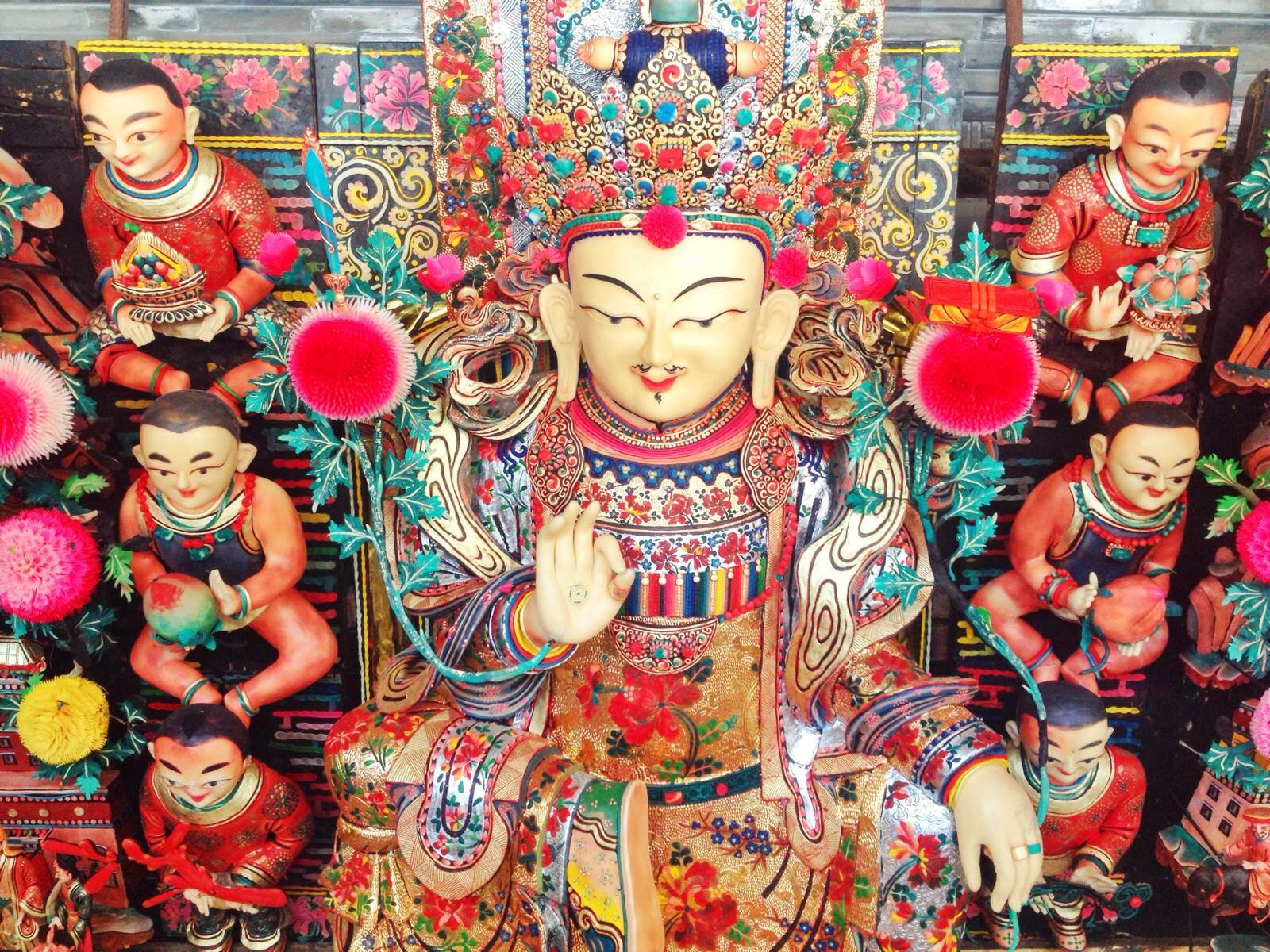
Located in an eight-petal lotus-like col south of Lusar Town, Huangzhong County, about 25 kilometers away from Xining, Kumbum Monastery is one of the first batch of major national historical and cultural sites certified by the State Council of China. In Tibetan, Kumbum means “a Maitreya monastery with hundred thousand lion-roaring Buddhas.” This sacred pilgrimage destination is renowned for butter sculptures, frescoes and barbola.
Butter sculptures originated from Bon, a Tibetan religious tradition or sect. Originally, they were small decals on offerings. According to legend, when she came to Tibet in 641, Princess Wencheng brought a statue of Jowo Shakyamuni, representing the Buddha at age twelve, and enshrined it at Jokhang, Lhasa. Local people paid their respects to the Buddha by serving flowers made of butter. Later, this kind of offering, treated as a treasure, was widely used in Buddhist monasteries in Tibet. Since then, butter sculptures have been a significant part of Monlam prayer festival in the first Tibetan month. In the process of development, butter sculptures evolve in many aspects like manufacturing mode, color variety, themes and crafts. In 1409, the event of Monlam was established by Tsongkhapa at Jokhang where large-scale butter sculptures were offered to the Buddha statues. Later, butter sculptures were introduced to Tsongkhapa’s birthplace Kumbum Monastery and became a custom here. On the fifteenth day the highlight of Monlam at Kumbum would be the “Butter Lamp Festival” (Chunga Chopa). People make and appreciate butter sculptures while praying for luck and security. This custom has lasted for several hundred years and never discontinued.
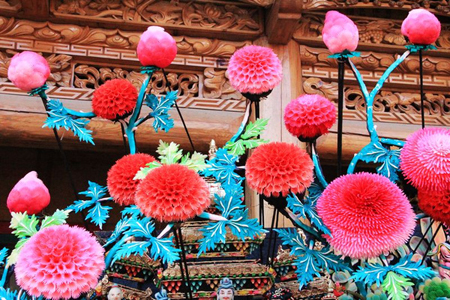
The making of butter sculptures involves six processes: framing, mold-making, modeling, shaping, assembling, and consecration. At Kumbum, most large-sized butter sculptures are themed by Buddhism (such as Jataka Tales of Shakyamuni, Twelve Great Deeds of Shakyamuni, The Life Story of Padmasambhava, and The Life Story of Tsongkhapa, all Buddha statues with the 32 signs of a Great Man), while some feature Tibetan operas, legendary or historical figures (such as Princess Wencheng Going to Tibet), in addition to delicate small butter flowers. A black mixture made from the used butter sculptures and ashes from burned wheat straw is employed to mold different shapes on the frame. Temperature is a critical factor during manufacturing which is quite challenging. A large butter sculpture could consist of many elements, such as tens of architectures, hundreds of figures and animals, two-meter-high statues of Bodhisattvas and Heavenly Kings, and millimetric flowers, birds, fishes and insects, with a remarkable harmony between figures and background, holiness and mundaneness, and dynamic state and static state. Despite complicated structure, butter sculptures still maintain clear visual quality, colorful coordination, integrity, and breathtaking beauty. During the display of butter sculptures, a dozen monks play instruments in the near distance.
Kumbum Monastery has two special organizations for the manufacturing of butter sculptures, the Upper Sculpture House and the Lower Sculpture House, both comprising about twenty monks dedicated to butter sculptures since they came here at the age of 15 or 16. Sculpturing crafts have been passed on from masters to apprentices, generations after generations. The chief inspector of the House is responsible for the decision of sculptures’ theme, composition, and task allocation. The main inheritors at Kumbum Monastery are Tashi Nyima, Losang Lhundrup, Kelsang Gyatso, Jamyang Sherab, and Dripa Rozi.
After religious reforms in 1958, religious activities were halted in Tibet, and monks were evacuated from monasteries. When butter sculpting was revived in the 1980s, most senior monks in this field had passed away. Butter sculptures are quite prone to deformation, meaning they cannot exist for a long time. Therefore, there are no fixed models or templates. We should attach great importance to the inheritance of this traditional craft and ensure its existence.
Relevant Inheritors : Kelsang Gyatso
Relevant Description:
I. Introduction
As a sacred pilgrimage destination, Kumbum Monastery is renowned for butter sculptures, frescoes and barbola.
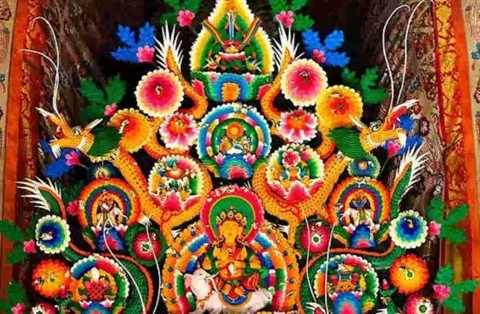
Located in a lotus-like col south of Lusar Town, Huangzhong County, about 25 kilometers away from Xining, Kumbum Monastery is a Buddhism center in northwest China. In Tibetan, Kumbum means “a Maitreya monastery with hundred thousand lion-roaring Buddhas.” This magnificent monastery occupies an area of up to 1,000 mu. At one time, there were more than 800 halls in total. As one of the six major Gelug monasteries, Kumbum also enjoys a high reputation even in Southeast Asia.
Butter is a kind of yellowish white Tibetan food made from milk after repeated agitation. This grease is of solid, soft and clean texture and of remarkable plasticity. As an indigenous art of butter and mineral pigments, these sculptures feature ingenious shapes, harmonious composition, colorful diversity, and festive and auspicious visual effect. Tibetan people firmly believe that anyone who wholeheartedly makes offerings of butter sculptures to Buddhas, Bodhisattvas, and dharmapalas will be free from disasters, get happiness, fortune and other benefits, and will rapidly become enlightened or awakened.
II. Origin
Butter sculptures originated from Bon, a Tibetan religious tradition or sect. Originally, they were small decals on offerings. According to Indian traditions, six kinds of offerings are necessary for the consecration of Buddhas and Bodhisattvas, namely flowers, paste incenses, pure water, incenses, fruits and Buddhist lamps. However, there were no fresh flowers in Tibet in winter. People had to prepare butter flowers as a substitute, creating a new form of art actually.
In 1409, the event of Monlam was established by Tsongkhapa at Jokhang where large-scale butter sculptures were offered to the Buddha statues. Later, butter sculptures were introduced to Tsongkhapa’s birthplace Kumbum Monastery and became a custom here. According to legend, Tsongkhapa, born at Kumbum Monastery, once dreamed that vines and thorns became bright lamps, weeds became flowers, and myriads of pearls glittered among those lamps and flowers. After waking from the dream, he organized monks to reproduce his dream by using butter sculptures and offered them to Buddha statues on the night of the fifteen day of that month. Therefore, before the 1950s, all butter sculptures would burn out before daybreak, as a symbol of impermanence.
Usually several months before the Spring Festival, craftsmen employ white butter and mineral pigments to make Buddha statues, figures, flowers, trees, birds and beasts. Some are elements of sculptures depicting religious stories, heavenly life, mundane life, or fairy tales. On the fifteenth day the highlight of Monlam at Kumbum would be the “Butter Lamp Festival” (Chunga Chopa). People make and appreciate butter sculptures while praying for luck and security. This custom has lasted for several hundred years and never discontinued.
According to legend, when she came to Tibet in 641, Princess Wencheng brought a statue of Jowo Shakyamuni, representing the Buddha at age twelve, and enshrined it at Jokhang, Lhasa. Local people paid their respects to the Buddha by serving flowers made of butter. Later, this kind of offering, treated as a treasure, was widely used in Buddhist monasteries in Tibet. Since then, butter sculptures have been a significant part of the Monlam prayer festival in the first Tibetan month. In the process of development, butter sculptures evolve in many aspects like manufacturing mode, color variety, themes and crafts.
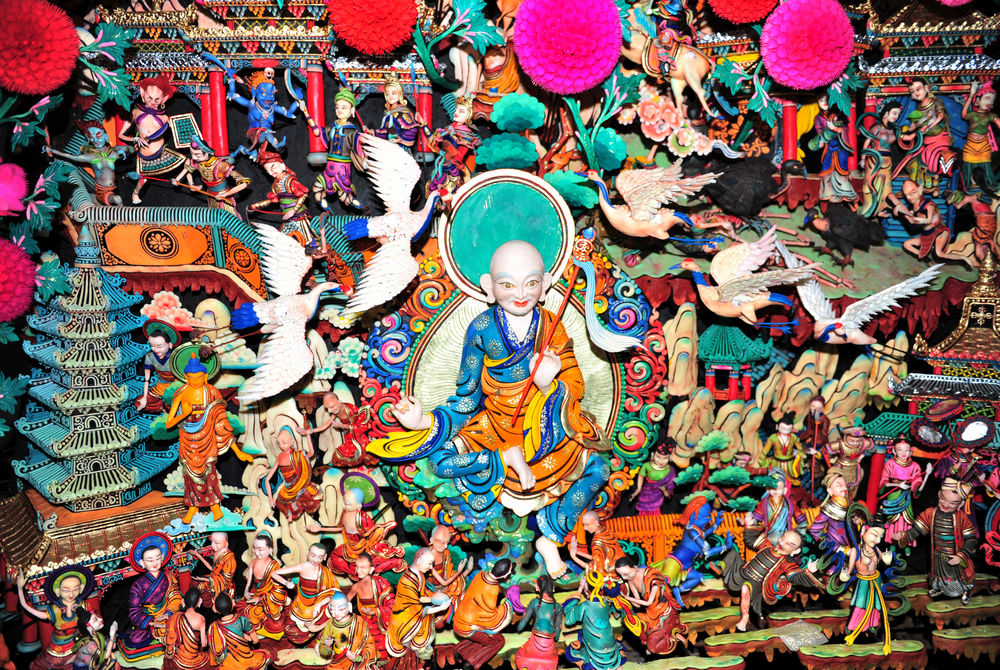
III. Workmanship
The manufacturing of butter sculptures at Kumbum Monastery is supported by a complete set of organization and scientific procedures. There are two special mechanisms, the Upper Sculpture House and the Lower Sculpture House, both treating the other as a competitor. Both Houses comprise about twenty monks dedicated to butter sculptures since they came here at the age of 15 or 16. The chief inspector of the House is responsible for the decision of sculptures’ theme, composition, and task allocation. Butter sculpting inherits the essence of Tibetan Buddhism art, being elaborate, various and ingenious. Its design and manufacturing are passed on from masters to apprentices, generations after generations. Generally, butter sculptures are crafted in enclosed spaces.
Since they have no communications on themes and crafts, the two Houses both have established own styles as they develop while competing with each other. Every year, they demonstrate their works based on their new crafts. The main inheritors at Kumbum Monastery are Tashi Nyima, Losang Lhundrup, Kelsang Gyatso, Jamyang Sherab, and Dripa Rozi.
In addition to technical complexity, butter sculpting is also time-consuming, a three-month period from preparations (in the tenth month of the Tibetan calendar) to final display (on the fifteenth day of the first month of the next year). To make butter fine, smooth and operable, monks would repeatedly scrub and knead it in cold water to enhance its purity and tenacity. Prepared butter is in pasty form for further application. Before sculpting, religious rituals are performed after monks have a bath and make vows. When rituals finish, the chief inspector and monks begin to discuss the themes of proposed sculptures. After setting the theme, they elaborate on the concept, planning and layout of sculptures. During this process, the work is distributed among the monks respectively and specifically. When all of the preparatory work is completed, the monks enter rooms at the temperature of minus zero degrees Celsius and begin their work.
The first procedure is to set up a basic frame for the butter sculpture. This is performed using some simple tools, such as soft leather, hemp ropes, bamboo poles or other sticks. In the next procedure, modeling, two kinds of raw materials are employed. The first kind is a black mixture made from used butter sculptures and ashes from burned wheat straws to mold different shapes on the frame. This process greatly resembles dough sculpting or clay sculpting. Then, the body must be revised and examined on shape, size and structural proportion by the chief director before the model is finally set up. The other raw material is a mixture made from pasty butter and various mineral pigments. This mixture is painted onto the surface of the body, and golden and silver powder is used to draw the outline of the sculpture. In the last step, butter sculptures are fastened by iron wires onto several planks or a special basin as in the original design. The layout is carefully arranged, with well-spaced and well-proportioned sculpts such as architectures, Bodhisattvas or Heavenly Kings as high as several meters, or flowers, birds, insects and fishes only several centimeters wide. The whole sculpture is vivid and lifelike with complete and stereoscopic prominence.
Butter sculptures are displayed about 20 degrees forward, providing a good perspective for viewers and avoiding that the melt of upper sculpts stain lower parts. Generally speaking, due to the influence of temperature, butter sculptures are remodeled every one or two years.
With a low melting point, butter becomes out of shape at 15 degrees Celsius and melts at about 25 degrees Celsius. Since human body temperature is higher than butter’s melting point, monks have to cool their hands in cold water, again and again, during the whole sculpting process. As a consequence, joint diseases are quite common among these monks. Some of them even have disabled fingers. If without devotion to the Buddhism and religious art, they were unable to make it. Year after year, in sunless workshops, warm colors of spring and dreams are flowed on the tips of monks’ frozen fingers. In their hearts, butter sculptures can talk stories about Buddha lands, mundane longings, beauty, and visions.
Butter sculptures are various in theme and rich in content. Sculptures of Buddhas, Bodhisattvas, heavenly kings, birds, animals, flowers, fishes, insects, mountains, trees, bonsais, and architectures come together to present complete stories. Simple or complicated here and there, integrated stereoscopic impression is formed following the skillful usage of comprehensive cavalier perspective and detailed focus prospective.
Butter sculptures demonstrate a free expression of story-telling. In limited spaces, tens of stories, which actually happened at different places and times, are put together in just one work as a whole, such as The Life Stories of Shakyamuni. Also, Princess Wencheng, made in the 1980s, feature nearly 300 figures, magnificent landscape of Chang’an, Riyue Mountain, Sanjiangyuan and Lhasa, and matching decorations of exotic flowers and plants. Historic scenes of harmony and friendship between Han and Tibetan peoples are reproduced vividly and grandly.
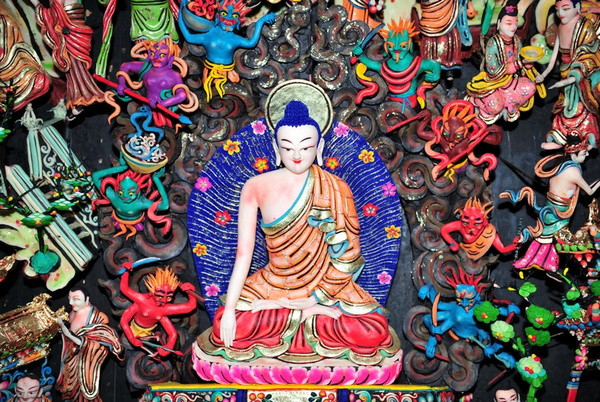
IV. Inheritance Significance
Before, butter sculptures were purely religious offerings; now, they gradually become festive displays. The relative decline of religious significance sees the prominence of artistic value. The themes of butter sculptures are becoming more and more mundane, given that even Tiananmen has been sculpted. Sculpting means are also diversified with combinations of cubic sculpting and embossment, single sculpting and group sculpting, and frame and basin. An increasing number of global art lovers are paying close attention to Tibetan butter sculpting.
However, butter sculpting still faces some problems in inheritance. After religious reforms in 1958, religious activities were halted in Tibet, and monks were evacuated from monasteries. When butter sculpting was revived in the 1980s, most senior monks in this field had passed away. Butter sculptures are quite prone to deformation, meaning they cannot exist for a long time. Therefore, there are no fixed models or templates. We should attach great importance to the inheritance of this traditional craft and safeguard its existence.